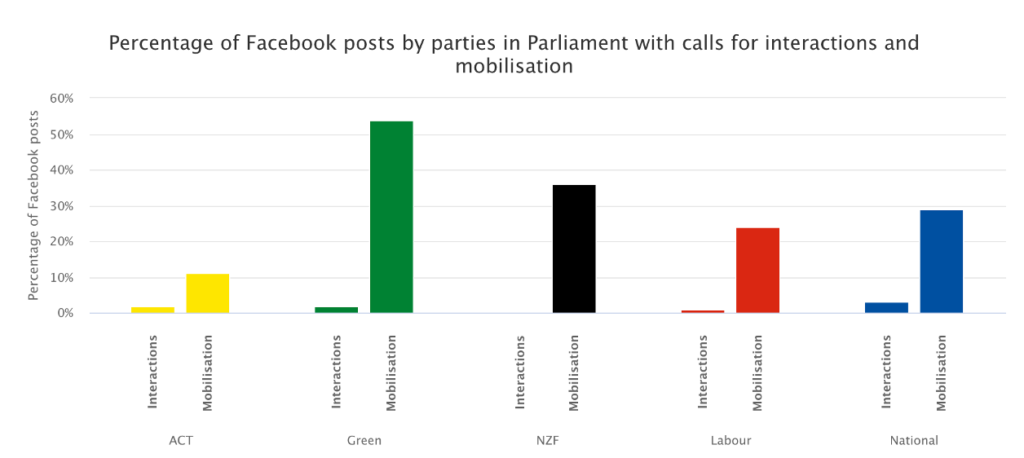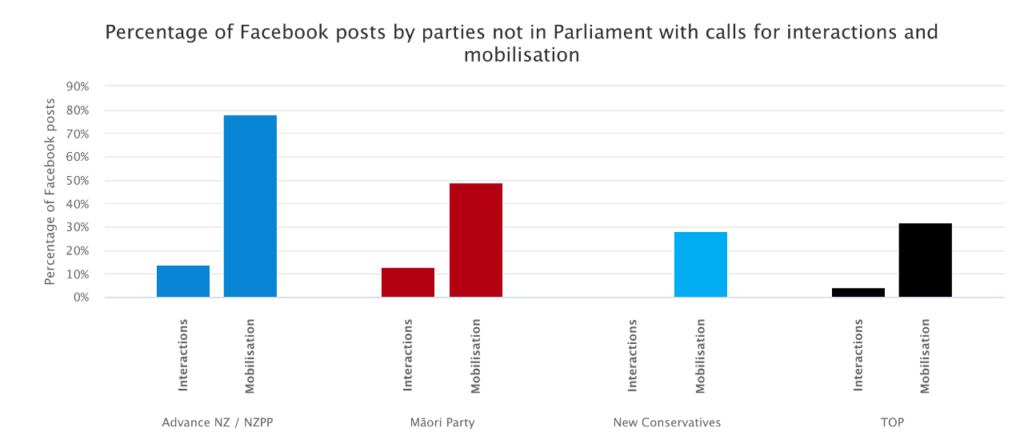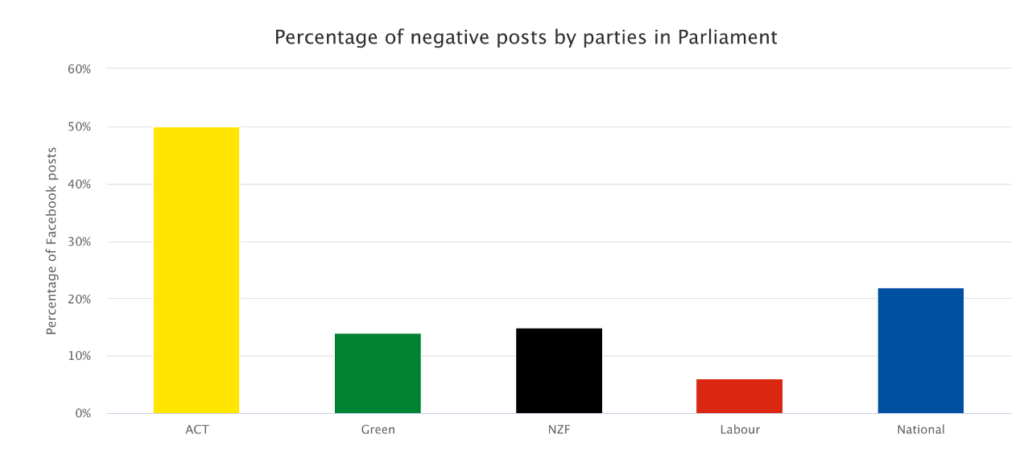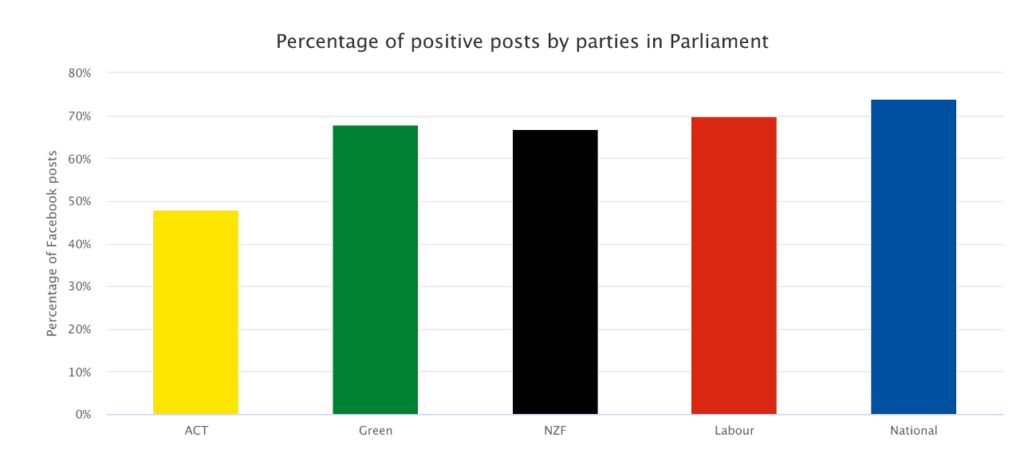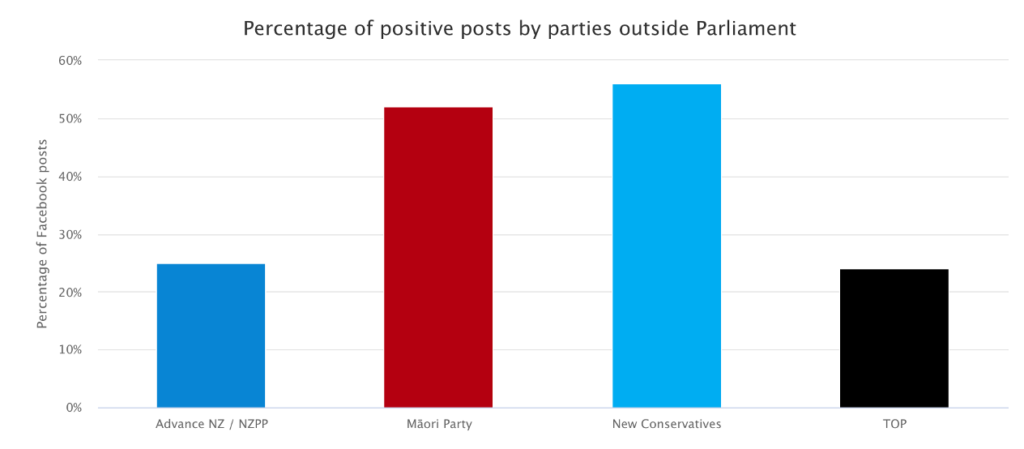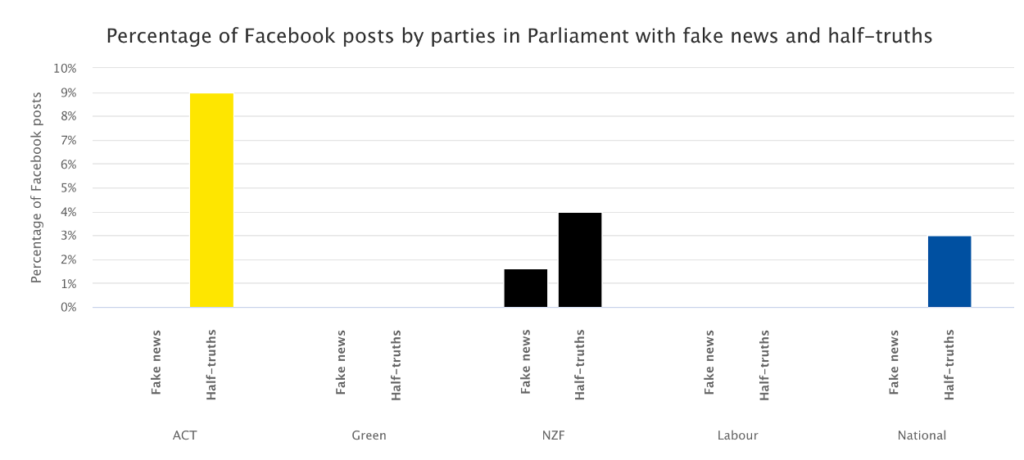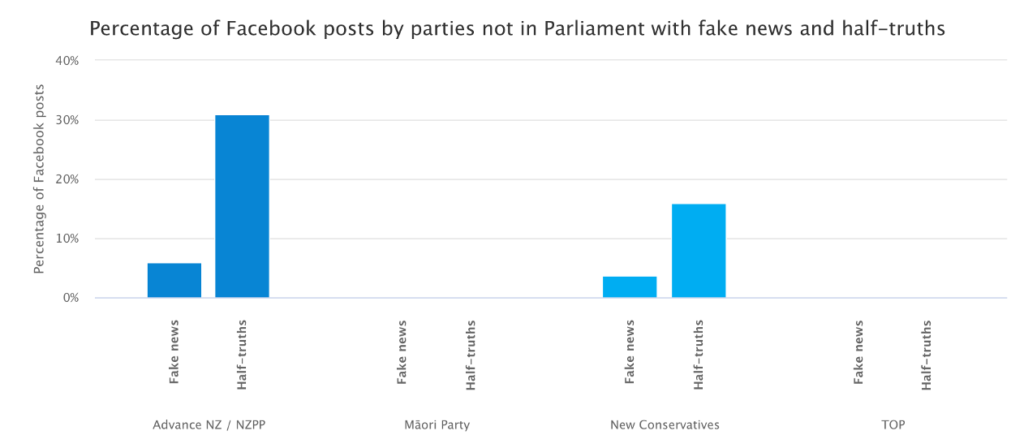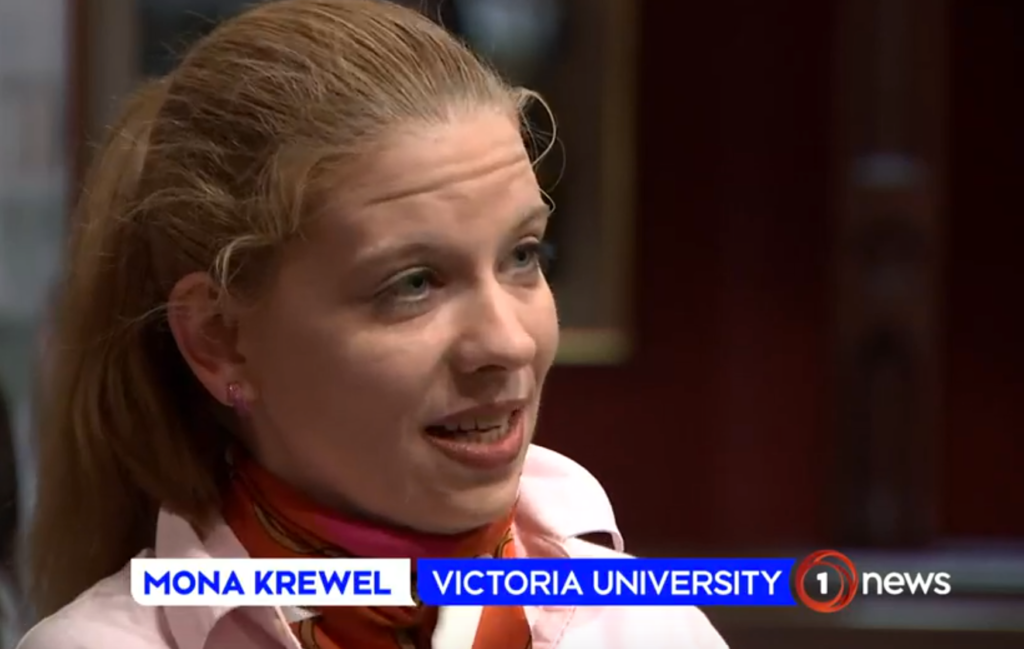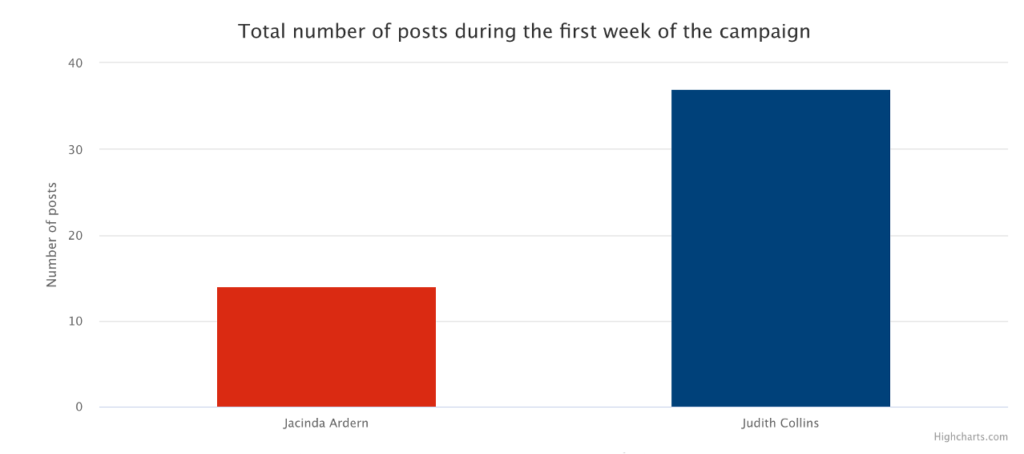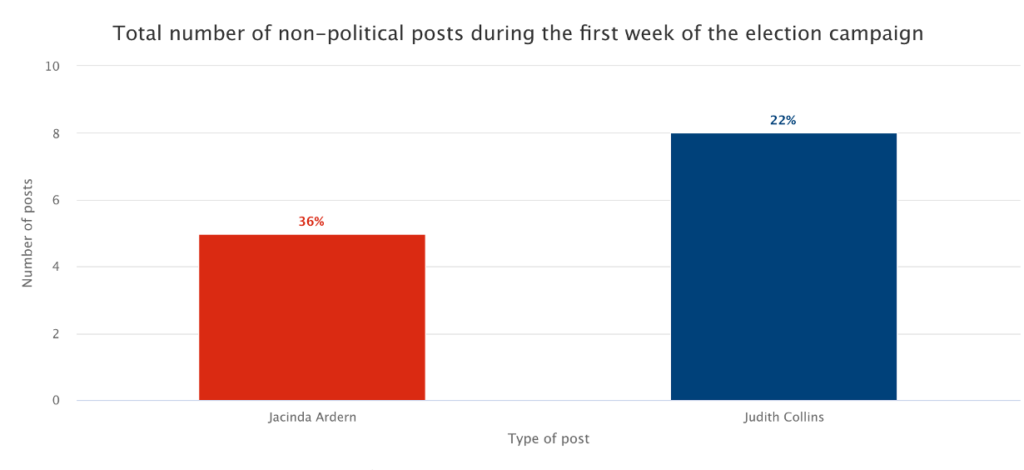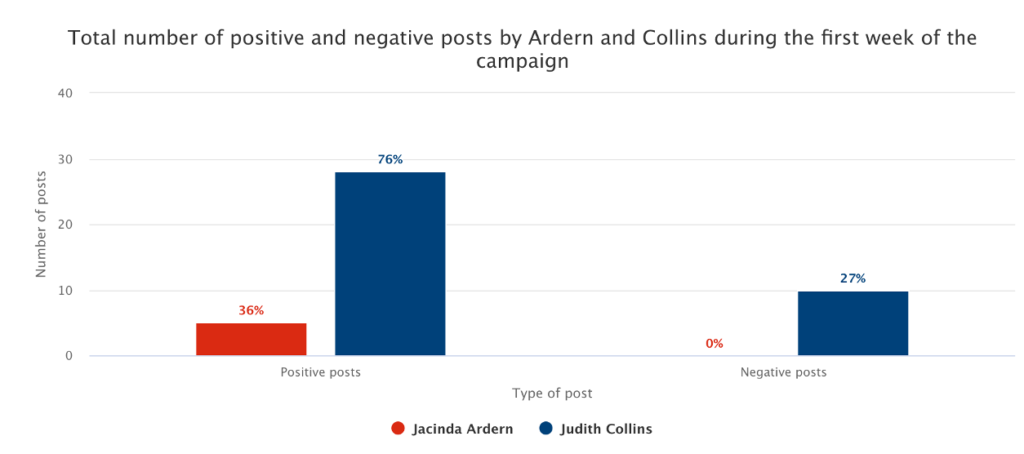Repost from Te Herenga Waka Victoria University’s Website
The leaders of the smaller parties in the 2020 New Zealand general election faced off in last week’s minor parties’ debate on TV. But how well are the campaigns of the minor parties and their leaders going on social media? What political topics are they campaigning on? Are they and their leaders ‘going dirty’? And is yesterday’s shutdown of Advance New Zealand’s Facebook page justified?
In their content analysis study of social media, Professor Jack Vowles and Dr Mona Krewel from Te Herenga Waka—Victoria University of Wellington’s Political Science and International Relations programme have now coded and analysed 1,936 Facebook posts placed by political parties and their leaders for the time period of 17 September–8 October, and will continue to code new posts until election day. The parties covered are Labour, National, the Greens, New Zealand First, ACT, The Opportunities Party (TOP), the Māori Party, the New Conservatives, and Advance New Zealand, as well as their leaders.
This week, they shine light on the Facebook campaigns of the minor parties and their leaders, including some of those left out of the multi-leader debate.
“The major parties are focusing their campaigns on the economy, because more voters tend to identify the economy as important,” says Professor Vowles. “Among the minor parties, some identify other issues. ACT, New Zealand First, and TOP focus their campaigns on the economy; Advance New Zealand, the Greens, the Māori Party, and the New Conservatives emphasise other issues.”
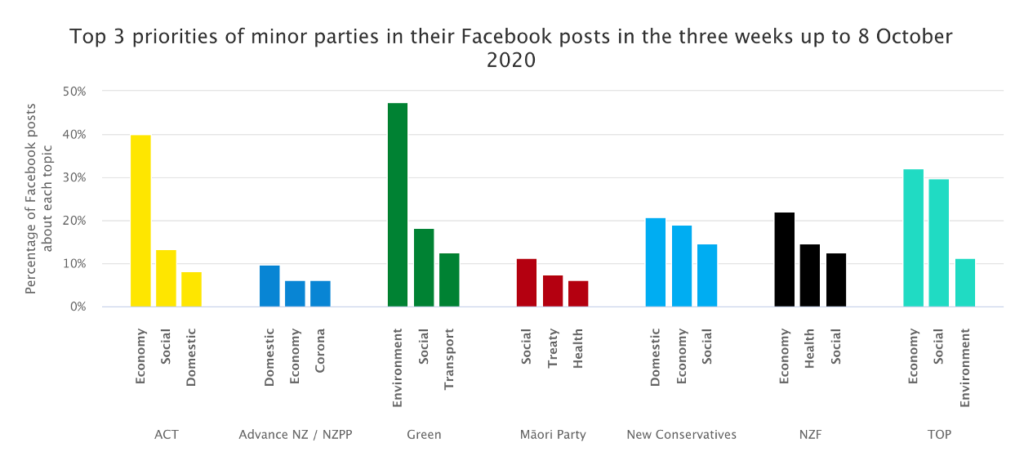
The Green Party focuses on the environment, he says, “which is not surprising, given their ‘reason for being’, and voters who identify the environment as their highest priority also tend to see the Greens as the party most committed to dealing with environmental issues. They are simply emphasising their main strength in their social media communication.
“The issues the Māori Party chooses to highlight are also consistent with what they stand for: they campaign on social issues in order to achieve better outcomes for Māori, who tend to be more concentrated among those on lower incomes. And, of course, the Māori Party also has the strongest focus on the Treaty of Waitangi.”
The story is a little different for Advance New Zealand, which also includes the New Zealand Public Party, says Dr Krewel. “Their agenda consists of seeking to convince voters the Government’s lockdown policies have unnecessarily limited New Zealanders’ freedom. Besides that, they have declared themselves an anti-corruption party—despite one of their leaders being investigated for corruption himself. This adds up to a strong focus on what we classify as domestic policies. The coronavirus also looms large in Advance New Zealand’s social media communications, as they are attempting to exploit the pandemic by spreading coronavirus conspiracy fears. Campaigning on economic insecurity and health is intended to attract people into their extreme ideology who under different circumstances would not have identified themselves with such polices. They hope spreading COVID-19 conspiracy theories and misinformation will be an effective strategy for them to radicalise anxious voters.”
However, adds Dr Krewel: “Opinion polling indicates only a few people are likely to vote for them, so their efforts have not been very effective, despite their social media impact. And on social media they have now also taken it too far by posting anti-vaccination adverts that yesterday led to Facebook’s decision to take their page down. However, they will surely use this as an opportunity to make a point against the global elites and the media trying to silence them, claiming to be the last party that is telling people the truth.”
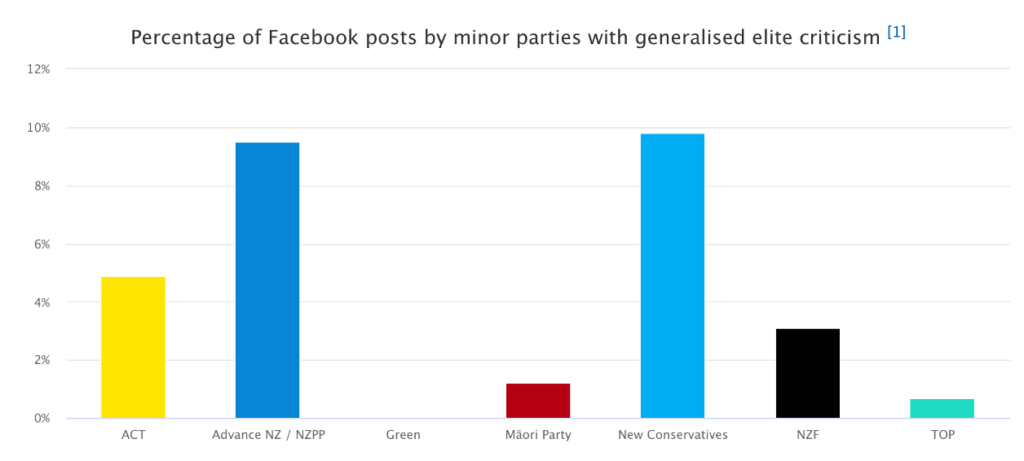
Professor Vowles notes that some commentators and political scientists describe such tactics and appeals as ‘populist’. “The New Zealand Public Party in particular campaigns against a global elite they claim has hidden objectives that lie behind governments’ responses to the coronavirus. The New Zealand Government and mainstream politicians are accused of being in thrall to global interests. This is an approach like that of the European radical right parties that border on fascism and are often described as ‘populist’. Indeed, nearly 10 per cent of Advance New Zealand—and also the New Conservatives—used a communication strategy of generalised elite criticism that is often labelled as populist. Such criticism is an obvious strategy for parties that have never been in power and therefore can campaign against the ‘establishment’ in general.”
But Professor Vowles adds that “while Advance New Zealand occasionally uses populist language centred on ‘the people’, by far its strongest language lies in the protection of individual freedom, not usually the territory occupied by a populist party. Like New Zealand First, its appeal is also nationalist, seeking to defend national sovereignty, and it has a strong Māori dimension.
“If we think of populism in two senses—as a campaign strategy based on the use of language and as a set of democratic norms—then Advance New Zealand uses some populist language, but also other language not usually defined in those terms. And in its claims to promote and defend the populist democratic norm that governments should be representative of ‘the people’, and thus majority public opinion, Advance New Zealand is no different from almost all New Zealand’s other political parties.
“In its opposition to the current coronavirus policy settings, Advance New Zealand rejects majority public opinion in favour of a defence of individual freedoms, fatally undermining its populist democratic credentials. Most New Zealanders continue to support a policy of collective action to protect society from the coronavirus, a preference far more consistent with the norms of democratic populism. If Advance New Zealand were a true populist party, we might expect them to be attracting more votes.”
For most of the campaign, like the major parties, the minor parties have been communicating with much more positive than negative language and their campaigns have become more positive over the course of the campaign, says Dr Krewel. “It is not surprising they become more positive as the campaign goes on. The closer we get to election day, the more the parties need to bring the focus of their campaigns back to themselves. You can attack your political opponents during the campaign, but on the ballot paper voters need to vote for you, not against the target of your negative messaging. Especially in a multi-party system where voters have a lot of options, you need to ensure they not only know for whom not to vote but also where to make their tick.”
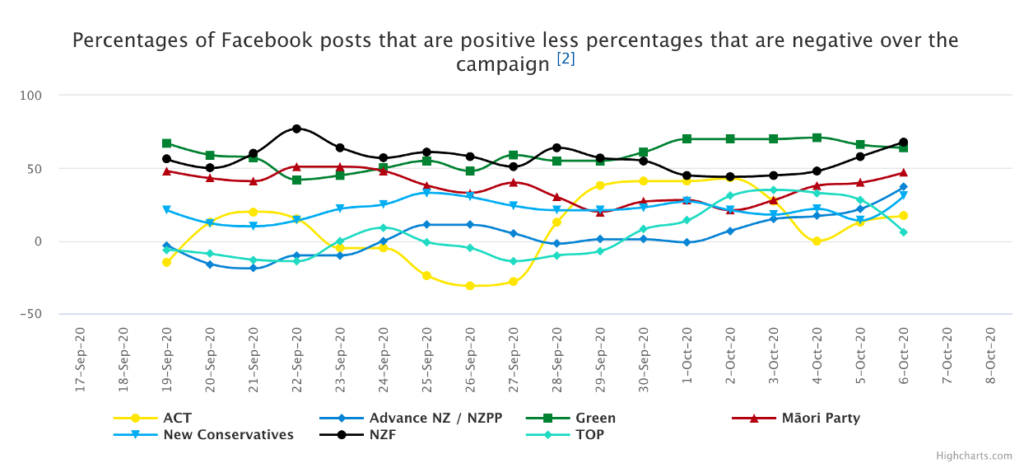
Dr Krewel notes that of the small parties in Parliament ACT has gone through much more of a roller-coaster of positive and negative campaigning over the course of the campaign than other parties. “This does not speak for a very coherent campaign strategy,” she says. “Or as campaigners say: you have to stay ‘on message’ in a campaign. You have to stick to the prearranged script or ideas you want to communicate and repeat those messages persistently: for example, the decision to run an attack campaign rather than emphasising your own advantages. But ACT has changed its messaging erratically from positive to negative campaigning back and forth over the entire campaign.”
David Seymour might have won the multi-leader debate according to Vote Compass respondents, she says, “but his party most likely has not won the Facebook campaign battle. Their unsteady campaign communication has probably confused voters more than it has benefited ACT.”
As mentioned in last week’s post , the minor parties engage more in the spreading of misinformation than the major parties, says Professor Vowles. “But it seems the minor party leaders have mostly avoided being associated with the dissemination of fake news or lending their faces to posts that contain half-truths. They post much less fake news and half-truths than their parties. To give some examples, only 3.7 per cent of Billy Te Kahika’s posts have contained fake news and 5.6 per cent half-truths, while already in week two of our study Advance New Zealand/NZPP’s posts contained 6 percent fake news and 31 percent half-truths. It is therefore not surprising Facebook yesterday took the party’s page down, but so far has not yet taken any action against Billy Te Kahika’s page. Similarly, only 1.3 percent of David Seymour’s posts contain half-truths, while 9 percent of his party’s posts contained information that was not fully accurate. There is an overlap in who posts misinformation. It is the same ‘usual suspects’. Where the parties engage in spreading false information, the leaders do too. It is simply not as much.”
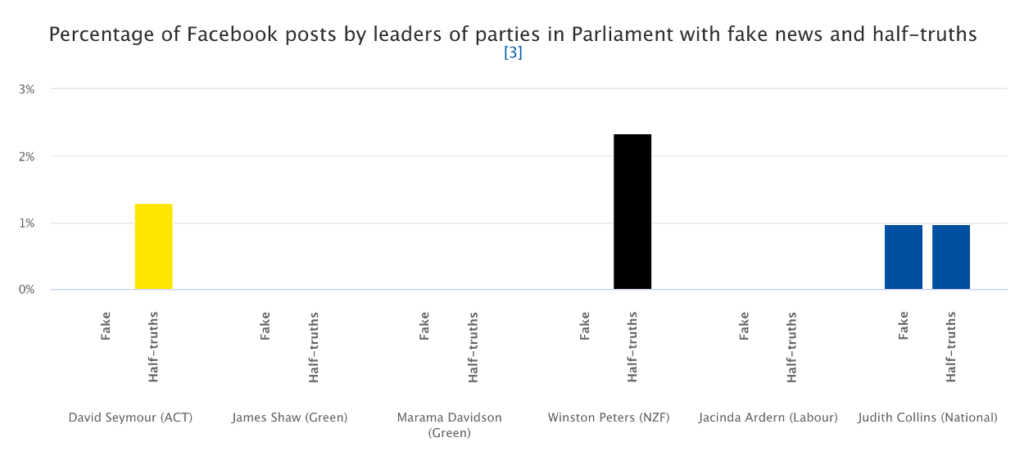
For Dr Krewel, this bears some resemblance to the findings of research on negative campaigning in television advertisements in the United States: “Some of the most negative TV advertisements in the US tend to come from third-party actors, such as the so-called PACs (political action committees). These are organisations that pool campaign contributions and fund campaigns. The candidates they support leave it up to the PACs to attack their opponents to minimise a possible backlash and keep their own record clean. It seems that in a similar way the party leaders tend not to spread fake news or promote half-truths and try to keep a clean slate, letting their parties take the blame instead.”
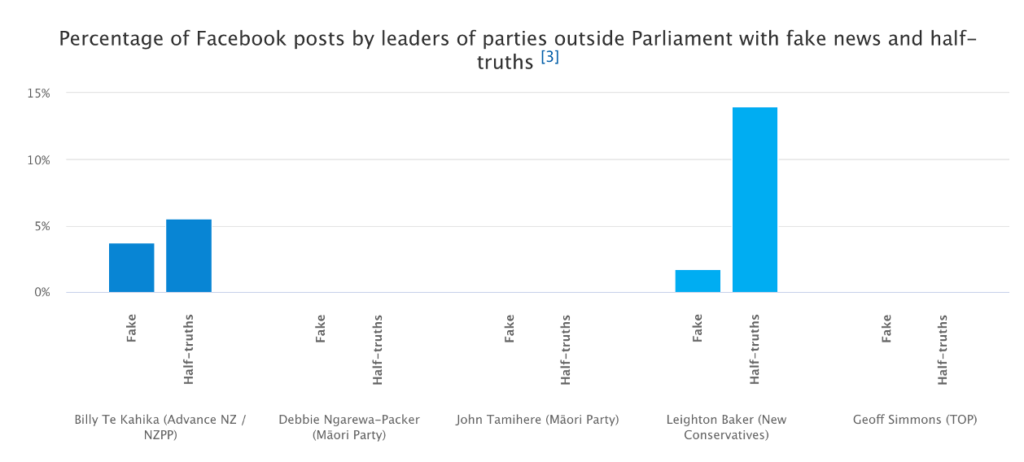
CrowdTangle, a public insights tool owned and operated by Facebook, has been used to collect the data on which this commentary is based. This sample has then been coded by five human coders on the basis of CamforS/DigiWorld’s codebook.
Footnotes
- (1) A post contained populist elite criticism when it a) blamed the elite (from any sector) as a group/the system in general for problems and grievances the people suffer or when elites are held responsible for anything undesirable from the people’s perspective; when it b) questioned the elite’s legitimacy to take decisions; when it c) called for resistance against the elite and their ideas and for direct popular decisions; and when it d) accused the elite of betraying the people or acting against the people’s interest or being corrupt.
- (2) A post could include both negative and positive statements. Based on the valence and strength of the used statements, pictures or emotions, the post could be of a negative or positive but also balanced nature. This tendency could be derived from the overall impression of the statements, pictures and emotions included in the post. The decisive factor for coding was the impression about the valence of the statements, pictures and emotions an average reader would get after looking at the post.
- (2) A post contained negative campaigning when it aimed at critically presenting the political opponent. This involved all forms of attack on the political opponent (party, politician, coalition, institution). Negative campaigning criticises socially relevant topics, uses stereotypical traits, highlights shortcomings as well as criticises and attacks qualities and behaviour of parties, politicians and related issues. Moreover, exaggerations and negative emotions such as fear, envy, blame and anger have also been considered negative campaigning.
- (2) A post contained positive campaigning when it included positive statements, pictures and emotions of a supporting, encouraging, affirmative, beneficial or assertive nature and presented the advantages of a party’s own candidate, their goals and competencies. The graph shows the positive less the negative news.
- (2) A five-day moving average has been used to smooth out short-term fluctuations and highlight the trend of the campaign period.
- (3) A post contained fake news when it was completely or for the most part made up and intentionally and verifiably false to mislead voters. The usual disagreements and accusations between political actors were not coded as fake news here. If a coder assumed a post could include fake news, but was not fully sure, they were asked to do some fact-checking and visit news websites of reliable sources to see if something had already been identified as fake news. In case of doubt, coders were asked to take a conservative approach and code the absence of fake news. Therefore, the graphs presented here under- rather than overestimate the extent of fake news in the campaigns.
- (3) When a post did not classify as fake news, coders were additionally asked if it contained half-truths—eg. things that were not completely accurate.
